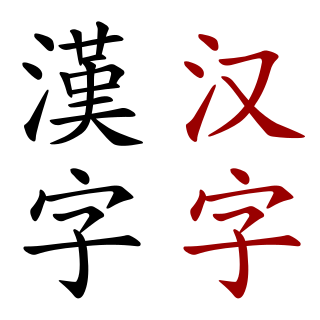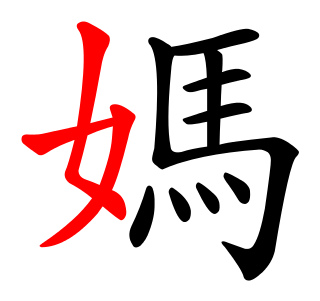
Chinese characters are logograms developed for the writing of Chinese. They have been adapted to write a number of other Asian languages. They remain a key component of the Japanese writing system and are occasionally used in the writing of Korean. They were formerly used in Vietnamese and Zhuang. Collectively, they are known as CJK characters. Vietnamese is sometimes also included, making the abbreviation CJKV.

A homograph is a word that shares the same written form as another word but has a different meaning. However, some dictionaries insist that the words must also sound different, while the Oxford English Dictionary says that the words should also be of "different origin". In this vein, The Oxford Guide to Practical Lexicography lists various types of homographs, including those in which the words are discriminated by being in a different word class, such as hit, the verb to strike, and hit the noun a blow.

A Chinese radical is a graphical component of a Chinese character under which the character is traditionally listed in a Chinese dictionary. This component is often a semantic indicator, though in some cases the original semantic connection has become obscure, owing to changes in character meaning over time. In other cases, the radical may be a phonetic component or even an artificially extracted portion of the character.

Traditional Chinese characters are Chinese characters in any character set that does not contain newly created characters or character substitutions performed after 1946. They are most commonly the characters in the standardized character sets of Taiwan, of Hong Kong and Macau, and in the Kangxi Dictionary. The modern shapes of traditional Chinese characters first appeared with the emergence of the clerical script during the Han Dynasty, and have been more or less stable since the 5th century.

Shuowen Jiezi was an early-2nd-century Chinese dictionary from the Han Dynasty. Although not the first comprehensive Chinese character dictionary, it was the first to analyze the structure of the characters and to give the rationale behind them, as well as the first to use the principle of organization by sections with shared components, called radicals.
The Dai Kan-Wa Jiten is a Japanese dictionary of kanji compiled by Tetsuji Morohashi. Remarkable for its comprehensiveness and size, Morohashi's dictionary contains over 50,000 character entries and 530,000 compound words. Haruo Shirane (2003:15) says: "This is the definitive dictionary of the Chinese characters and one of the great dictionaries of the world."
Japanese dictionaries have a history that began over 1300 years ago when Japanese Buddhist priests, who wanted to understand Chinese sutras, adapted Chinese character dictionaries. Present-day Japanese lexicographers are exploring computerized editing and electronic dictionaries. According to Keisuke Nakao:
It has often been said that dictionary publishing in Japan is active and prosperous, that Japanese people are well provided for with reference tools, and that lexicography here, in practice as well as in research, has produced a number of valuable reference books together with voluminous academic studies. (1998:35)

Variant Chinese characters are Chinese characters that are homophones and synonyms. Almost all variants are allographs in most circumstances, such as casual handwriting. Some contexts require the usage of certain variants, such as in textbook editing.
The Iroha Jiruishō is a 12th-century Japanese dictionary of Kanji. It was the first Heian Period dictionary to collate characters by pronunciation rather than by logographic radical or word meaning.

Chinese dictionaries date back over two millennia to the Han Dynasty, which is a significantly longer lexicographical history than any other language. There are hundreds of dictionaries for the Chinese language, and this article introduces some of the most important.

The 1615 Zìhuì is a Chinese dictionary edited by the Ming Dynasty scholar Mei Yingzuo (梅膺祚). It is renowned for introducing two lexicographical innovations that continue to be used in the present day: the 214-radical system for indexing Chinese characters, which replaced the classic Shuowen Jiezi dictionary's 540-radical system, and the radical-and-stroke sorting method.

The Hanyu dazidian is a reference work on Chinese characters.
The Shinsen jikyō is the first Japanese dictionary containing native kun'yomi "Japanese readings" of Chinese characters. The title is also written 新選字鏡 with the graphic variant sen for sen.
The Jikyōshū was a circa 1245 CE Japanese dictionary of Chinese characters. The "Mirror of Characters" title echoes the Shinsen Jikyō, and the internal organization closely follows the Ruiju Myōgishō.
The Kagakushū, alternatively read as Gegakushū, was a 1444 Japanese dictionary of Chinese characters arranged into semantic headings. The title alludes to Confucius' self-description in the Lunyu: 下学而上達 "My studies lie low, and my penetration rises high."

Jack Halpern is a Japan-based Israeli lexicographer specializing in Chinese characters or kanji. He is best known as editor-in-chief of the Kodansha Kanji Learner's Dictionary and as the inventor of the SKIP system for kanji lookup. Halpern is also an active unicyclist, having served as founder and president of the International Unicycling Federation. He currently resides in Saitama, Japan.
The Shenglei 聲類, compiled by the Cao Wei dynasty lexicographer Li Deng 李登, was the first Chinese rime dictionary. Earlier dictionaries were organized either by semantic fields or by character radicals. The last copies of the Shenglei were lost around the 13th century, and it is known only from earlier descriptions and quotations, which say it was in 10 volumes and contained 11,520 Chinese character entries, categorized by linguistic tone in terms of the wǔshēng 五聲 "Five Tones " from Chinese musicology and wǔxíng 五行 "Five Phases/Elements" theory.
The Zilin or Forest of Characters was a Chinese dictionary compiled by the Jin dynasty (265–420) lexicographer Lü Chen (呂忱). It contained 12,824 character head entries, organized by the 540-radical system of the Shuowen Jiezi. In the history of Chinese lexicography, the Zilin followed the Shuowen Jiezi and preceded the Yupian.

The Yunhai jingyuan 韻海鏡源 Ocean of Rhymes, Mirror of Sources Chinese dictionary, which was compiled by the Tang dynasty official and calligrapher Yan Zhengqing (709–785), was the first phonologically-arranged rime dictionary of words rather than characters. Although the Yunhai jingyuan is a lost work, several later dictionaries, such as the (1711) Peiwen Yunfu, followed its system of collating entries by the tone and rime of the last character in a term.

The (1254) Zitong 字通 or Mastery of Characters is a Chinese dictionary of orthography that was compiled by the Southern Song dynasty (1127-1279) scholar Li Congzhou 李從周. It discussed logographic differences among Chinese characters written in the ancient Qin dynasty seal script, standard Han dynasty clerical script, and contemporary Song regular script.












